The global gas desiccant dehydration unit market is projected to reach USD 2.1 billion by 2035, recording an absolute increase of USD 811.4 billion over the forecast period. The market is valued at USD 1.3 billion in 2025 and is set to rise at a CAGR of 5.1% during the assessment period. The overall market size is expected to grow by nearly 1.6 times during the same period, supported by increasing demand for natural gas processing infrastructure and moisture removal systems, driving demand for efficient dehydration technologies and increasing investments in pipeline infrastructure and gas quality management systems globally.
The market demonstrates steady growth momentum driven by expanding natural gas production requiring stringent moisture removal to prevent pipeline corrosion and hydrate formation, rising liquefied natural gas (LNG) export capacity demanding ultra-low moisture specifications, and growing shale gas development necessitating comprehensive gas treatment infrastructure.
Growth is particularly concentrated in onshore oil and gas applications serving conventional and unconventional production operations, offshore platforms requiring compact, reliable dehydration systems, and midstream processing facilities where moisture control ensures pipeline integrity and downstream equipment protection. The global energy transition continues to support natural gas infrastructure investment, with gas dehydration units serving as critical enabling technologies for safe, efficient natural gas transmission and processing operations.
Technology advancement in desiccant materials and process optimization is reshaping market dynamics, with manufacturers developing enhanced triethylene glycol (TEG) regeneration systems improving efficiency and reducing emissions, advanced molecular sieve formulations offering superior moisture removal and longer service life, and automated control systems enabling remote monitoring and predictive maintenance capabilities.
The natural gas industry's focus on operational efficiency creates sustained demand for dehydration units featuring reduced energy consumption, minimized chemical losses, and extended maintenance intervals lowering total cost of ownership. Stricter pipeline gas quality specifications, particularly moisture content limits preventing hydrate formation and corrosion, drive adoption of reliable dehydration systems across gathering, processing, and transmission operations.
Regional dynamics show accelerated growth across Asia Pacific markets, led by China's expanding natural gas infrastructure and India's growing gas consumption, while established markets in North America maintain substantial investments through shale gas production and LNG export facility development. However, commodity price volatility affecting capital expenditure decisions, competition from alternative dehydration technologies including membrane systems, and operational challenges in harsh environmental conditions may pose obstacles to market expansion in certain applications and cost-sensitive project contexts.
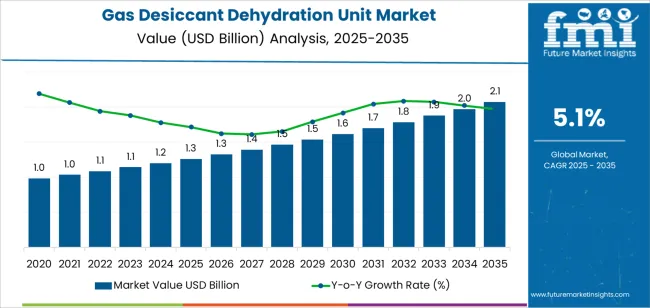
Between 2025 and 2030, the gas desiccant dehydration unit market is projected to expand from USD 1.3 billion to USD 1,614.6 billion, resulting in a value increase of USD 355.5 billion, which represents 43.8% of the total forecast growth for the decade. This phase of development will be shaped by rising demand for natural gas processing infrastructure and pipeline quality management systems, technology innovation in advanced desiccant materials and energy-efficient regeneration processes, as well as expanding shale gas production and LNG export capacity driving comprehensive gas treatment requirements. Companies are establishing competitive positions through investment in modular system designs, digital monitoring platforms, and strategic market expansion across onshore production, offshore platforms, and midstream processing applications.
From 2030 to 2035, the market is forecast to grow from USD 1,614.6 billion to USD 2.1 billion, adding another USD 455.9 billion, which constitutes 56.2% of the overall ten-year expansion. This period is expected to be characterized by the expansion of LNG liquefaction capacity requiring ultra-low moisture specifications, strategic collaborations between equipment manufacturers and engineering contractors, and an enhanced focus on emission reduction technologies and environmentally responsible glycol handling systems. The growing emphasis on operational efficiency and environmental compliance will drive demand for advanced, reliable gas dehydration solutions across diverse natural gas production, processing, and transmission applications.
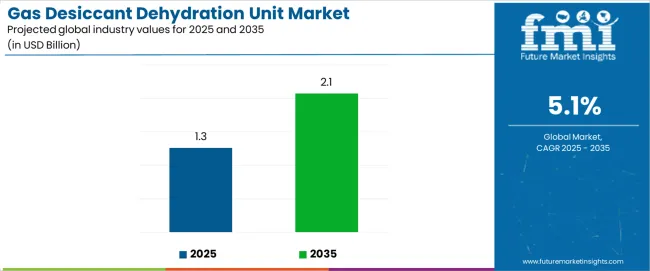
| Metric | Value |
|---|---|
| Market Value (2025) | USD 1.3 billion |
| Market Forecast Value (2035) | USD 2.1 billion |
| Forecast CAGR (2025 to 2035) | 5.1% |
The gas desiccant dehydration unit market grows by enabling natural gas producers and pipeline operators to achieve stringent moisture specifications, prevent hydrate formation, and ensure pipeline integrity while meeting regulatory requirements and downstream processing standards. Gas processing operations face mounting pressure to deliver pipeline-quality gas specifications, with dehydration units typically reducing moisture content to 4-7 pounds per million standard cubic feet (lb/MMSCF) or lower, making gas dehydration essential for corrosion prevention, hydrate avoidance, and equipment protection across gathering, processing, and transmission infrastructure. The natural gas industry's need for reliable moisture removal creates demand for proven dehydration technologies that can handle variable gas compositions, operate in extreme environmental conditions, and maintain consistent performance across multi-year service intervals.
Government pipeline safety regulations and gas quality standards drive adoption in production operations, midstream processing facilities, and pipeline transmission systems, where moisture control has a direct impact on infrastructure integrity and operational safety. The global expansion of natural gas as transition fuel accelerates dehydration unit demand as producers develop new gas fields, expand LNG export capacity, and build pipeline infrastructure connecting supply sources to demand centers. However, capital cost constraints affecting project economics and operational complexity requiring specialized maintenance expertise may limit adoption rates among smaller producers and projects with limited budget flexibility or technical resources.
The market is segmented by dehydration system type, application, and region. By dehydration system type, the market is divided into TEG gas dehydration system, molecular sieve gas dehydration system, and others. Based on application, the market is categorized into onshore oil and gas, offshore oil and gas, and others. Regionally, the market is divided into Asia Pacific, Europe, North America, Latin America, and Middle East & Africa.
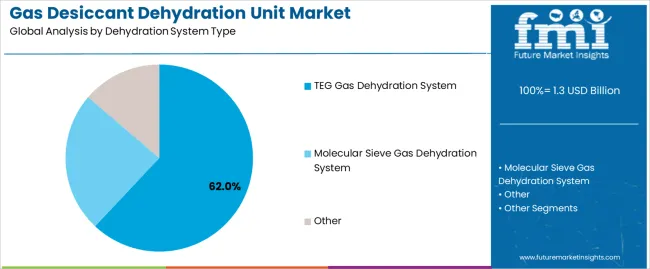
The TEG gas dehydration system segment represents the dominant force in the gas desiccant dehydration unit market, capturing approximately 62% of total market share in 2025. This established technology category encompasses liquid desiccant systems utilizing triethylene glycol (TEG) for gas-liquid contact absorption, delivering proven reliability, operational flexibility, and cost-effective moisture removal suitable for diverse gas compositions and flow rates across onshore and offshore applications. The TEG system segment's market leadership stems from its exceptional adaptability to variable operating conditions including gas composition changes and flow rate fluctuations, mature technology status providing extensive operational experience and proven reliability track record, and favorable economics for moderate-to-large gas processing applications where capital and operating costs deliver compelling project economics.
The molecular sieve gas dehydration system segment maintains a substantial 32.0% market share, serving applications requiring ultra-low moisture specifications including LNG feed gas preparation, gas processing plant inlet treatment, and specialized applications demanding dew point depression to -100°F or lower. Other dehydration technologies including membrane systems, refrigeration-based methods, and hybrid approaches account for the remaining 6.0% market share.
Key advantages driving the TEG gas dehydration system segment include:
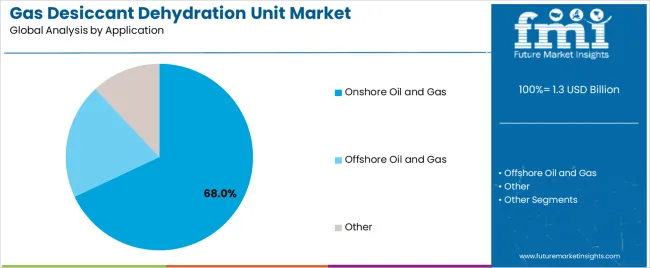
Onshore oil and gas applications dominate the gas desiccant dehydration unit market with approximately 68% market share in 2025, reflecting the predominance of land-based production operations, extensive gathering system networks, and comprehensive midstream processing infrastructure requiring moisture removal across conventional fields, shale formations, and tight gas developments. The onshore segment's market leadership is reinforced by sheer volume of land-based production operations spanning diverse geographic regions, capital investment concentration in onshore development projects offering superior economic returns, and infrastructure density including extensive gathering systems and processing facilities serving multiple production wells through centralized treatment operations.
The offshore oil and gas segment represents 24% market share through platform-based dehydration requirements, subsea gas processing applications, and floating production systems demanding compact, reliable moisture removal in space-constrained, harsh marine environments. Other applications including industrial gas processing, biogas upgrading, and specialty gas treatment account for the remaining 8% market share.
Key market dynamics supporting application preferences include:
The market is driven by three concrete demand factors tied to natural gas infrastructure expansion and quality requirements. First, global natural gas production growth creates increasing requirements for dehydration capacity, with production expanding 2-4% annually in major producing regions including United States, Middle East, and Asia Pacific, requiring new dehydration units and capacity expansions serving growing gas volumes. Second, LNG export capacity expansion drives demand for ultra-low moisture specifications, with global liquefaction capacity additions exceeding 50 million tonnes per annum requiring comprehensive gas treatment including dehydration to stringent specifications preventing equipment freeze-up and ensuring process reliability. Third, pipeline integrity management and corrosion prevention requirements accelerate adoption across gathering systems, transmission pipelines, and distribution networks where moisture removal prevents internal corrosion, extends infrastructure lifespan, and maintains system reliability.
Market restraints include commodity price volatility affecting capital expenditure decisions, particularly during sustained periods of low natural gas prices where producers curtail development projects and defer infrastructure investments including dehydration capacity additions. Alternative dehydration technologies including membrane systems and hybrid approaches create competitive pressure, offering advantages in specific applications including offshore platforms where footprint constraints favor compact membrane solutions, potentially displacing traditional desiccant-based systems in certain market segments. Operational challenges including glycol losses, emission control requirements, and maintenance complexity pose additional barriers, as environmental regulations tighten controls on volatile organic compound (VOC) emissions from TEG regenerators while molecular sieve systems require periodic changeouts and regeneration gas management.
Key trends indicate accelerated adoption of modular, skid-mounted dehydration units, particularly for shale gas applications where rapid deployment, standardized designs, and transportable configurations enable flexible capacity additions matching production growth and facilitating relocation as drilling pads develop. Technology advancement trends toward automated control systems with remote monitoring capabilities are enabling unmanned operation, predictive maintenance scheduling, and real-time performance optimization reducing operating costs and improving reliability. However, the market thesis could face disruption if breakthrough membrane or alternative dehydration technologies achieve performance and cost parity with established desiccant systems, potentially fundamentally restructuring technology preferences and market share distribution across application segments.
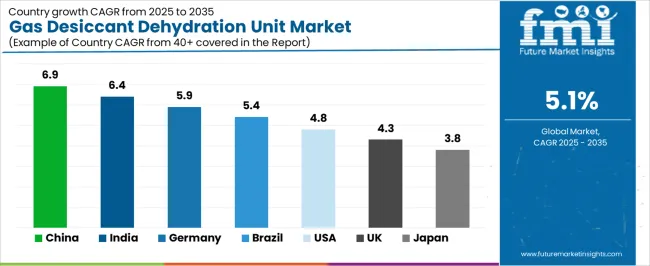
| Country | CAGR (2025-2035) |
|---|---|
| China | 6.9% |
| India | 6.4% |
| Germany | 5.9% |
| Brazil | 5.4% |
| USA | 4.8% |
| UK | 4.3% |
| Japan | 3.8% |
The gas desiccant dehydration unit market is gaining momentum worldwide, with China taking the lead thanks to aggressive natural gas infrastructure development and expanding pipeline networks serving growing domestic demand. Close behind, India benefits from rising natural gas consumption and infrastructure investments connecting domestic production and LNG import terminals, positioning itself as a strategic growth hub in the Asia-Pacific region. Germany shows strong advancement, where energy security initiatives and natural gas infrastructure modernization strengthen its role in European gas supply chains.
The USA demonstrates robust growth through continued shale gas production and LNG export capacity expansion, signaling sustained investment in gas processing infrastructure. Meanwhile, Japan stands out for its LNG import infrastructure and gas quality management requirements, while the UK continues recording progress through North Sea operations and gas infrastructure maintenance. Together, China and India anchor the global expansion story, while established markets build operational efficiency and technology advancement into the market's growth path.
The report covers an in-depth analysis of 40+ countries top-performing countries are highlighted below.
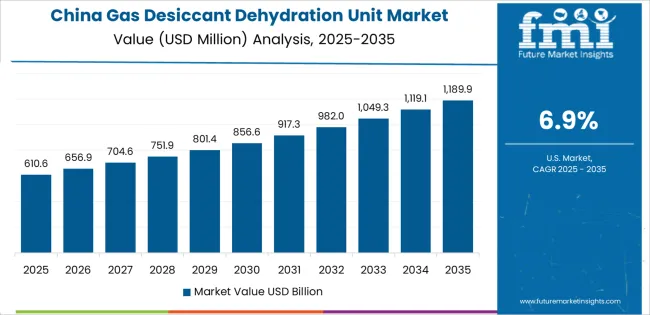
China demonstrates the strongest growth potential in the Gas Desiccant Dehydration Unit Market with a CAGR of 6.9% through 2035. The country's leadership position stems from comprehensive natural gas development strategies prioritizing domestic production growth, extensive pipeline infrastructure construction connecting western production regions to eastern demand centers, and rising gas consumption supporting environmental policies transitioning from coal to cleaner-burning natural gas. Growth is concentrated in major gas-producing regions, including Xinjiang, Sichuan, and Shaanxi provinces, where conventional and unconventional gas development requires comprehensive treatment infrastructure including dehydration capacity serving production operations and long-distance pipeline transmission. Government support through infrastructure investment programs and gas industry development policies accelerates dehydration unit deployment across upstream production, midstream processing, and transmission pipeline operations. The country's domestic equipment manufacturing capabilities combined with substantial project pipeline create favorable environment for sustained market expansion.
Key market factors:
In major gas-producing regions including Krishna-Godavari Basin, Cambay Basin, and Rajasthan areas, the deployment of gas dehydration infrastructure is accelerating across production operations, processing facilities, and pipeline networks, driven by domestic gas production initiatives, LNG import terminal expansions, and growing gas consumption in power generation and industrial sectors. The market demonstrates strong growth momentum with a CAGR of 6.4% through 2035, linked to comprehensive energy infrastructure modernization and increasing focus on natural gas utilization addressing air quality concerns and energy security objectives. Indian gas producers and pipeline operators are implementing dehydration systems ensuring pipeline quality specifications while navigating cost sensitivity and building operational expertise managing complex gas treatment operations.
Germany's natural gas infrastructure demonstrates sophisticated dehydration system integration, with established pipeline networks, underground storage facilities, and import terminals requiring comprehensive moisture management ensuring system integrity and operational reliability. The country's gas infrastructure in major pipeline corridor regions showcases integration of dehydration technologies with existing systems, leveraging expertise in process engineering and automation. German operators emphasize reliability standards and environmental compliance, creating demand for advanced dehydration systems featuring emission controls, energy efficiency, and comprehensive monitoring capabilities. The market maintains steady growth through infrastructure modernization and capacity optimization, with a CAGR of 5.9% through 2035.
Key development areas:
Brazil's substantial offshore natural gas production creates significant dehydration requirements, with pre-salt fields and conventional offshore developments requiring comprehensive gas treatment on production platforms and floating production units. The country shows solid potential with a CAGR of 5.4% through 2035, driven by offshore field development, domestic gas market expansion, and natural gas monetization initiatives addressing historically high gas flaring and reinjection. Brazilian operators implement compact, reliable dehydration systems optimized for offshore environments where space constraints, motion conditions, and unmanned operation requirements drive specialized equipment specifications.
Key market characteristics:
The U.S. market demonstrates substantial dehydration capacity installed base and continuing additions serving shale gas production, conventional operations, and midstream infrastructure expansions. The country shows solid potential with a CAGR of 4.8% through 2035, driven by ongoing shale production in major basins, LNG export capacity expansions, and gathering system developments connecting new production to processing facilities. American operators deploy diverse dehydration technologies optimized for specific applications from wellhead dehydration units to large-scale midstream processing facilities treating billions of cubic feet per day.
Leading market segments:
The UK's gas dehydration market focuses on North Sea offshore production platforms, aging infrastructure maintenance, and pipeline system operations connecting offshore fields to onshore terminals. The country maintains steady momentum with a CAGR of 4.3% through 2035, driven by continued North Sea operations despite mature field status, infrastructure life extension programs, and gas import infrastructure supporting energy security. British offshore operators implement reliable dehydration systems designed for unmanned platform operation, harsh marine environments, and extended maintenance intervals reflecting operational constraints and economic optimization requirements.
Key market characteristics:
In major LNG import regions including Tokyo Bay, Osaka Bay, and other coastal terminal locations, gas handling operations require precise moisture management ensuring equipment protection and gas quality consistency across storage, regasification, and pipeline injection operations. The market shows steady potential with a CAGR of 3.8% through 2035, linked to substantial LNG import dependency, comprehensive receiving terminal infrastructure, and stringent gas quality standards protecting downstream pipeline systems and end-use equipment. Japanese operators implement advanced dehydration systems where required for specific gas sources or applications demanding ultra-low moisture specifications.
Market development factors:
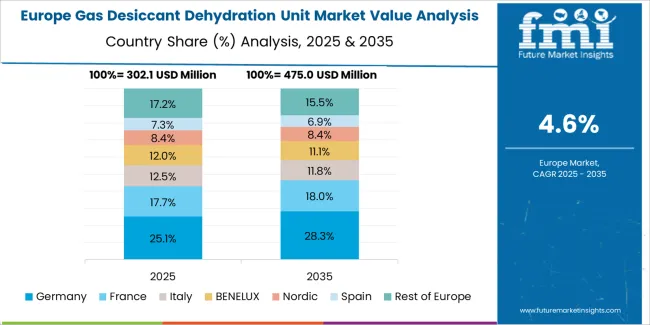
The gas desiccant dehydration unit market in Europe is projected to grow from USD 295.0 billion in 2025 to USD 465.0 billion by 2035, registering a CAGR of 4.7% over the forecast period. Germany is expected to maintain its leadership position with a 26.5% market share in 2025, declining slightly to 25.8% by 2035, supported by its extensive pipeline infrastructure and major gas transmission corridors connecting import sources to distribution networks. The United Kingdom follows with a 22.8% share in 2025, projected to reach 22.5% by 2035, driven by North Sea production operations and gas infrastructure maintenance.
The Netherlands holds a 18.5% share in 2025, expected to decline to 17.2% by 2035 reflecting Groningen field production phase-down. Norway commands a 15.2% share in 2025, rising to 16.8% by 2035 on continued offshore production and pipeline export operations. Italy accounts for 8.5% in 2025, rising to 8.8% by 2035 on import infrastructure development. France maintains 4.8% in 2025, reaching 5.1% by 2035 on gas infrastructure investments. The Rest of Europe region is anticipated to hold 3.7% in 2025, expanding to 3.8% by 2035, attributed to diverse infrastructure developments across Central and Eastern European gas networks.
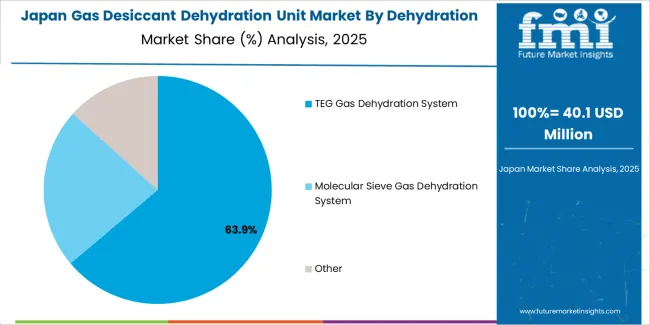
The Japanese gas desiccant dehydration unit market demonstrates mature LNG import focus, characterized by comprehensive receiving terminal infrastructure and sophisticated gas quality management systems ensuring consistent specifications across diverse supply sources. Japan's emphasis on energy security and supply reliability drives demand for dehydration systems where moisture management requirements exist, particularly for specific LNG sources or applications requiring ultra-low dew point specifications protecting downstream equipment and pipeline systems.
The market benefits from established relationships between Japanese utilities and international equipment suppliers, creating stable procurement ecosystems that prioritize reliability, proven technology, and comprehensive after-sales support. Major LNG import terminals showcase integration of gas treatment systems including dehydration capacity where specifications demand moisture removal beyond LNG regasification processes.
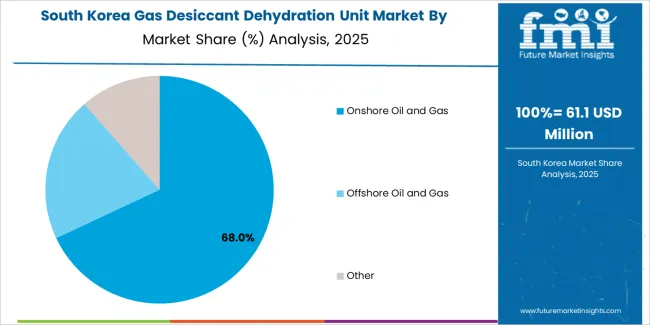
The South Korean gas infrastructure operates primarily through LNG imports, with dehydration requirements arising in specific operational contexts including domestic production operations, industrial gas processing, and specialized applications requiring moisture management. The market demonstrates focused application where dehydration serves particular operational requirements rather than universal LNG handling needs. Domestic operators source dehydration equipment through established procurement channels connecting international suppliers with Korean project execution, creating supply models supporting project-specific equipment provision and after-sales service. The competitive landscape features international equipment manufacturers serving Korean market through direct sales, representative offices, or partnerships with domestic engineering firms, providing comprehensive support encompassing equipment supply, installation supervision, and operational training.
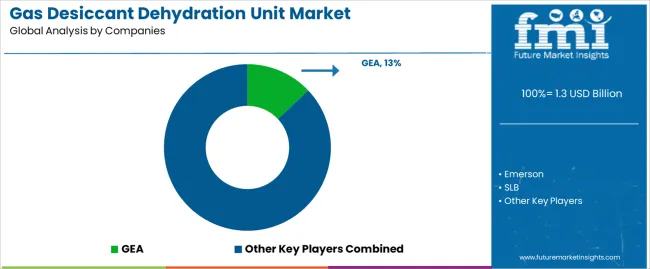
The gas desiccant dehydration unit market features approximately 30-40 meaningful players with moderate concentration, where established process equipment manufacturers and specialized gas treatment companies compete across technology platforms and application segments. Market leadership disperses across diverse company types including global industrial conglomerates offering comprehensive process solutions, specialized gas treatment equipment manufacturers, and regional suppliers serving specific geographic markets. Competition centers on technology performance, operational reliability, and total cost of ownership rather than equipment price alone, as end-users prioritize proven designs, vendor support capabilities, and lifecycle economics in equipment selection decisions.
Market leaders include GEA, Emerson, and SLB, which maintain competitive advantages through decades of gas processing expertise, comprehensive technology portfolios spanning multiple dehydration approaches, and global service networks supporting equipment commissioning, operation, and maintenance across diverse operating environments. These companies leverage extensive installed base providing operational experience and customer relationships, research and development capabilities advancing dehydration efficiency and emission controls, and comprehensive project execution capabilities spanning engineering, fabrication, and field services. GEA leads the market with 13% share.
Challengers encompass Veolia, CECO, and Pietro Fiorentini, which compete through specialized technology focus, regional market strength, or integrated solutions combining dehydration with complementary gas treatment processes. Specialized manufacturers, including Nihon Seiki, TransTech, and Wintek, focus on particular technology platforms such as molecular sieve systems or specific application niches including offshore platforms or distributed wellhead applications, offering differentiated capabilities in compact designs, automation sophistication, or cost-optimized configurations.
Regional manufacturers including VOGELBUSCH, Generon, and ALCO Inc. create competitive dynamics through localized manufacturing advantages, responsive customer service, and specialized expertise serving specific markets or applications. Market dynamics favor companies that combine proven technology performance with comprehensive support services and flexible commercial approaches addressing diverse customer requirements from turnkey supply through equipment-only procurement supporting customer-executed installations, alongside ongoing service relationships ensuring optimal system performance across multi-decade operating lifespans.
Gas desiccant dehydration units represent critical infrastructure components that enable natural gas producers and pipeline operators to achieve stringent moisture specifications preventing corrosion and hydrate formation, typically reducing water content to 4-7 lb/MMSCF or lower, delivering essential gas conditioning supporting safe, reliable transportation and processing operations. With the market projected to grow from USD 1,259.1 billion in 2025 to USD 2,070.5 billion by 2035 at a 5.1% CAGR, these process systems offer compelling value - infrastructure protection, operational reliability, and regulatory compliance - making them essential for onshore oil and gas applications (68.0% market share), offshore operations (24.0% share), and natural gas infrastructure requiring moisture management ensuring pipeline integrity, equipment protection, and gas quality specifications across production, processing, and transmission operations. Scaling effective deployment and optimizing performance requires coordinated action across energy policy, technical standards, equipment manufacturers, engineering contractors, and operator training initiatives.
| Item | Value |
|---|---|
| Quantitative Units | USD billion |
| Dehydration System Type | TEG Gas Dehydration System, Molecular Sieve Gas Dehydration System, Other |
| Application | Onshore Oil and Gas, Offshore Oil and Gas, Other |
| Regions Covered | Asia Pacific, Europe, North America, Latin America, Middle East & Africa |
| Country Covered | China, India, Germany, Brazil, USA, UK, Japan, and 40+ countries |
| Key Companies Profiled | GEA, Emerson, SLB, Veolia, CECO, Pietro Fiorentini, Nihon Seiki, TransTech, Wintek, Vogelbusch Group |
| Additional Attributes | Dollar sales by dehydration system type and application categories, regional adoption trends across Asia Pacific, North America, and Middle East & Africa, competitive landscape with established process equipment manufacturers and specialized gas treatment companies, technology comparison between TEG and molecular sieve systems, integration with natural gas production and pipeline infrastructure, emission control technologies addressing environmental regulations, modular design approaches enabling flexible deployment, and operational optimization strategies including energy efficiency improvements and predictive maintenance capabilities. |
The global gas desiccant dehydration unit market is estimated to be valued at USD 1.3 billion in 2025.
The market size for the gas desiccant dehydration unit market is projected to reach USD 2.1 billion by 2035.
The gas desiccant dehydration unit market is expected to grow at a 5.1% CAGR between 2025 and 2035.
The key product types in gas desiccant dehydration unit market are teg gas dehydration system, molecular sieve gas dehydration system and other.
In terms of application, onshore oil and gas segment to command 68.0% share in the gas desiccant dehydration unit market in 2025.






Full Research Suite comprises of:
Market outlook & trends analysis
Interviews & case studies
Strategic recommendations
Vendor profiles & capabilities analysis
5-year forecasts
8 regions and 60+ country-level data splits
Market segment data splits
12 months of continuous data updates
DELIVERED AS:
PDF EXCEL ONLINE
Gas Cylinder Market Size and Share Forecast Outlook 2025 to 2035
Gasket and Seal Market Size and Share Forecast Outlook 2025 to 2035
Gas Separation Membrane Market Size and Share Forecast Outlook 2025 to 2035
Gas Jet Compressor Market Size and Share Forecast Outlook 2025 to 2035
Gas Fired Water-Tube Food Processing Boiler Market Size and Share Forecast Outlook 2025 to 2035
Gas Fired Real Estate Generator Market Size and Share Forecast Outlook 2025 to 2035
Gastric-soluble Hollow Capsules Market Size and Share Forecast Outlook 2025 to 2035
Gas Cooling System Market Analysis - Size, Share, and Forecast Outlook 2025 to 2035
Gasoline Gensets Market Size and Share Forecast Outlook 2025 to 2035
Gas Turbine Oil Market Size and Share Forecast Outlook 2025 to 2035
Gas Telecom Generator Market Size and Share Forecast Outlook 2025 to 2035
Gas Fired Condensing Low Temperature Commercial Boiler Market Size and Share Forecast Outlook 2025 to 2035
Gas Insulated Medium Voltage Switchgear Market Size and Share Forecast Outlook 2025 to 2035
Gas Commercial Deep Fryers Market Size and Share Forecast Outlook 2025 to 2035
Gastroesophageal Reflux Disease (GERD) Device Market Analysis - Size, Share, and Forecast Outlook 2025 to 2035
Gas Station Equipment Market Size and Share Forecast Outlook 2025 to 2035
Gaskets Market Size and Share Forecast Outlook 2025 to 2035
Gas Chromatography Systems Market Size and Share Forecast Outlook 2025 to 2035
Gas Fueled Power Rental Market Size and Share Forecast Outlook 2025 to 2035
Gas Fired Water Tube Chemical Boiler Market Size and Share Forecast Outlook 2025 to 2035

Thank you!
You will receive an email from our Business Development Manager. Please be sure to check your SPAM/JUNK folder too.
Chat With
MaRIA